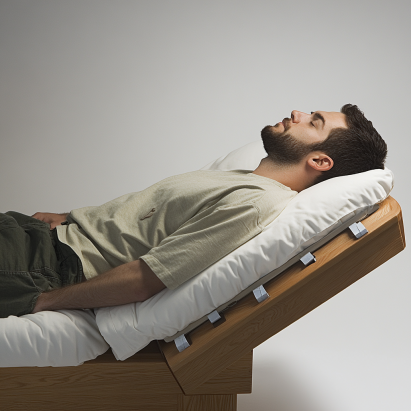Many people with sleep apnea struggle to breathe at night—but what if elevating your bed could help? Discover how Inclined Bed Therapy and sleep apnea relief go hand in hand.
Inclined Bed Therapy and Sleep Apnea: Does Sleeping on an Incline Help?

Key Takeaways
- Inclined Bed Therapy (IBT) may ease sleep apnea by improving airway openness during sleep.
- Elevating the head of the bed by 6 inches helps reduce snoring and boosts oxygen intake.
- IBT is a non-invasive, affordable supplement or alternative to CPAP therapy.
- Best combined with side sleeping, weight management, and proper sleep posture.
How Inclined Bed Therapy Helps with Sleep Apnea
Inclined Bed Therapy and sleep apnea have a promising connection. Sleep apnea, especially obstructive sleep apnea (OSA), happens when soft tissues in the throat collapse during rest, causing breathing pauses. According to the Sleep Foundation, OSA is the most common type of sleep apnea and can have serious long-term health effects if left untreated. By raising the head of your bed about 6 inches, gravity helps keep your airway open, reducing the number and severity of interruptions.
Why It Works
Sleeping flat often allows gravity to work against your airway, increasing the chance of collapse. Elevating your upper body slightly changes that dynamic. With Inclined Bed Therapy and sleep apnea management, you’re essentially giving your throat muscles a natural assist. It also minimizes snoring and can lead to deeper, uninterrupted sleep.
Benefits of IBT for Sleep Apnea
- Reduces Airway Collapse: Gravity helps keep tissues from blocking airflow.
- Decreases Snoring: Less tissue vibration means quieter nights.
- Boosts Oxygen Levels: Better airflow means more oxygen and less fatigue.
- Drug-Free & Simple: No machines or medications required—just lift the bed.
- Improves Sleep Quality: Fewer apnea events mean more restorative rest.
How to Set Up Inclined Bed Therapy for Sleep Apnea
Step 1: Choose Your Incline Method
- Bed Risers: Affordable and easy—place sturdy risers under your bed’s headposts.
- Adjustable Bed Frame: For flexibility and long-term use, this is the most precise method.
- Wedge Pillow: A less effective, but portable option to test the concept before committing.
Step 2: Make It Comfortable
- Supportive Mattress: A good mattress will ensure proper alignment during inclined sleep.
- Minimize Pillows: Too many pillows can strain your neck—stick to one or none.
- Check Bed Stability: Make sure the incline is secure and doesn’t shift overnight.
Helpful Lifestyle Tips for Sleep Apnea
- Lose Extra Weight: Extra fat can press against the airway, increasing sleep disruptions. The Cleveland Clinic recommends weight management as one of the most effective lifestyle strategies to improve sleep apnea symptoms.
- Sleep on Your Side: Back sleeping increases airway blockage—pair side sleeping with IBT.
- Avoid Alcohol and Sedatives: These relax muscles too much, leading to more collapse.
- Stay Hydrated: Dry throat tissues are more prone to sticking together during sleep.
- Use CPAP if Needed: Inclined Bed Therapy and sleep apnea therapy can work together for better results if prescribed.
Frequently Asked Questions
Can Inclined Bed Therapy replace CPAP machines?
Not entirely. While Inclined Bed Therapy and sleep apnea treatment can help reduce symptoms, CPAP remains the most effective treatment for moderate to severe cases. IBT works well as a supplemental approach.
How much should I elevate the bed?
A 6-inch incline is ideal for most people. It creates a 5–7° angle that supports breathing without disrupting comfort.
Does IBT work for central sleep apnea?
IBT primarily supports obstructive sleep apnea (OSA). Central sleep apnea is a neurological issue, so consult your doctor before trying IBT for that type.
Is it safe for daily use?
Yes. Most people adjust easily within a few nights. Just make sure your bed is stable and your mattress supportive.
Can IBT help with snoring if I don’t have apnea?
Absolutely. Snoring often improves with inclined sleeping even for people without a sleep apnea diagnosis.
Final Thoughts
Inclined Bed Therapy and sleep apnea relief can be life-changing—and it doesn’t require expensive gear or complex changes. If you or your partner struggle with snoring or nighttime breathing disruptions, elevating your bed might be the simplest, most natural solution you’ve yet to try.













